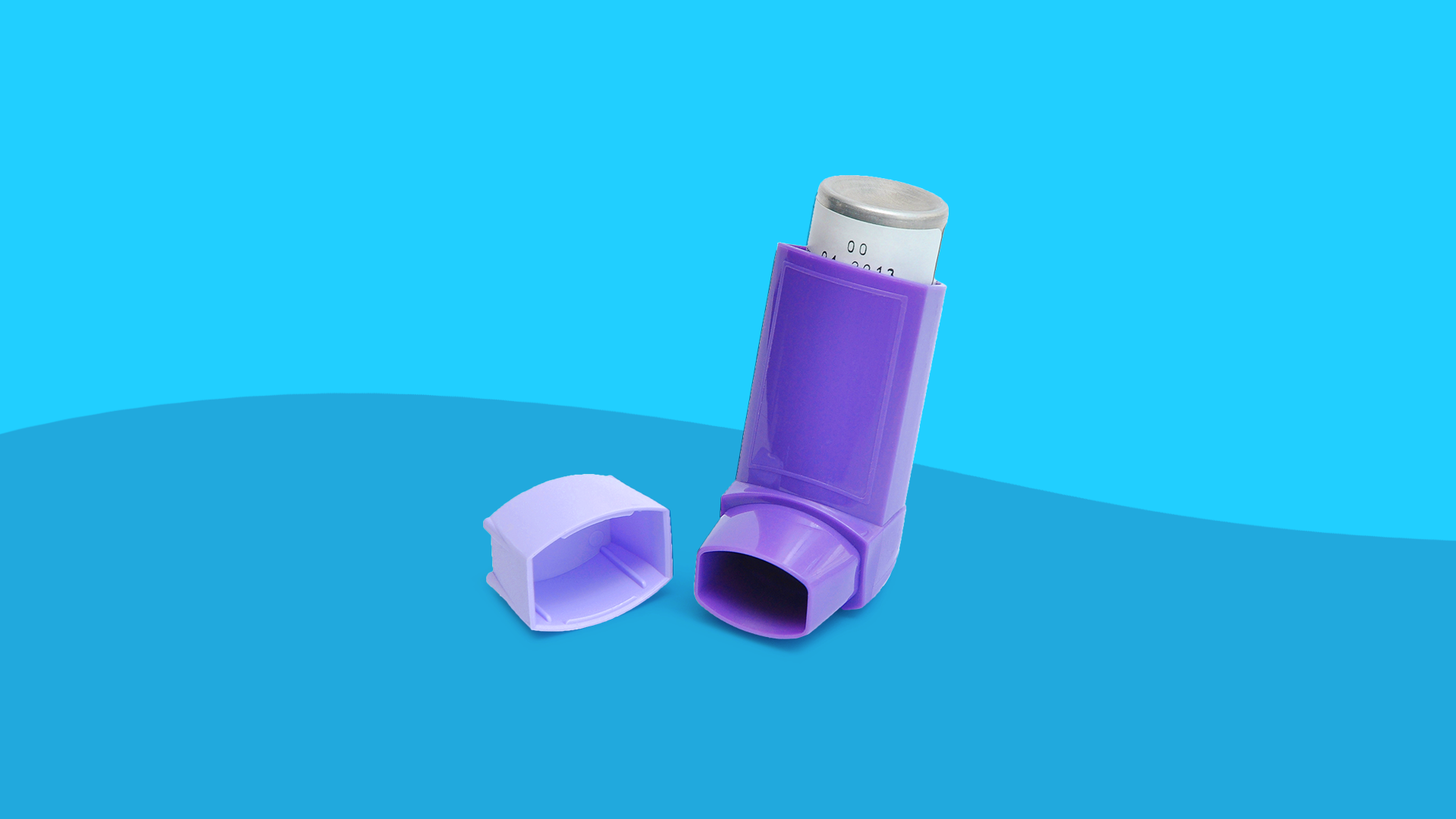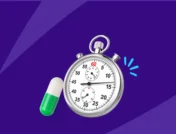Common Breo Ellipta side effects | Thrush | Pneumonia | Serious side effects | Cardiovascular events | Osteoporosis | How long do side effects last? | Warnings | Interactions | How to avoid side effects
Controlling symptoms of asthma and chronic obstructive pulmonary disease (COPD) and preventing flare-ups make a monumental difference in one’s quality of life. Breo Ellipta (fluticasone furoate-vilanterol), a brand-name inhaler, can be a part of a successful plan. The drug’s inhaled corticosteroid (ICS) fluticasone furoate reverses the airway inflammation of asthma and both types of COPD: emphysema and chronic bronchitis. Adding to that, vilanterol is a long-acting beta-2 adrenergic agonist (LABA) capable of relaxing bronchial smooth muscle to achieve a bronchodilator effect. The drug’s stimulation of bronchial beta-receptors not only takes effect rapidly but also lasts 24 hours. This means Breo Ellipta can be taken once daily, at either a 100 mcg/25 mcg or 200 mcg/25 mcg strength for asthma or 100 mcg/25 mcg strength for COPD.
Despite the enticing benefits and conveniences of Breo Ellipta, this dry powder inhaler (which comes preloaded with two measured blister strips of powder) has important, potential adverse effects. This review will delve into those adverse reactions, as well as cover drug information and conditions that can increase the risk of using Breo Ellipta.
RELATED: Get Breo Ellipta coupons | What is Breo Ellipta?
Common side effects of Breo Ellipta
The most common side effects of Breo Ellipta include:
- Nasopharyngitis, pharyngitis, sinusitis, or bronchitis (inflammatory conditions of the upper respiratory tract)
- Upper respiratory tract infection or influenza
- Cough
- Runny nose
- Pneumonia
- Headache
- Back pain or arthralgias (joint pain)
- Oral candidiasis (thrush)
- Hypertension (high blood pressure)
- Diarrhea
- Peripheral edema (swelling in the hands or feet)
- Fever
- Fractures
Oral candidiasis
Oral candidiasis is the technical term for thrush, a fungal infection of the mouth. Symptoms include white, adherent plaques on the tongue, roof of the mouth, and inside of the cheeks. These fungal patches can create soreness or taste disturbance. The ICS in Breo Ellipta elevates the risk of thrush, such that 5% of users experienced this complication compared to 2% of those taking placebo (inactive inhaler) in one study. The steroid is an immunosuppressant, and when acting inside the mouth, it allows the proliferation of the candida yeast that causes thrush. Rinsing one’s mouth with water after using Breo Ellipta can lessen the risk of thrush. Of note, it is important to spit out the water after rinsing to prevent swallowing the medication. Swallowed medication could contribute to esophageal candidiasis or systemic side effects. If thrush is experienced, antifungal treatment is available and effective, so consulting a medical provider is advisable.
Pneumonia
The immunosuppressant action of the ICS in Breo Ellipta is likely the culprit for an increase in pneumonia incidence. One clinical trial of the drug showed that 6% of Breo Ellipta users experienced pneumonia, compared to 3% of those using only vilanterol. Pneumonia symptoms can include fever, cough, shortness of breath, and chest pain. It can be a serious and life-threatening lung infection. Accordingly, worsening symptoms demand medical attention.
Serious side effects of Breo Ellipta
- Paradoxical bronchospasm (bronchial spasm rather than dilation after use)
- Hypersensitivity allergic reactions (symptoms such as hives)
- Anaphylaxis (severe life-threatening allergic reaction)
- Hypotension (low blood pressure)
- Angina (chest pain), cardiac arrest (heart stoppage), or arrhythmia (abnormal heart rhythm)
- Hypokalemia (low potassium level)
- Hyperglycemia (high blood sugar level)
- Osteoporosis (low bone mineral density) or fractures
- Eosinophilia (high allergy immune cell count)
- Adrenal insufficiency (inadequate natural adrenal cortisol production)
- Hypercorticism (excess blood cortisol level from the drug)
- Immunosuppression (weakened immune system)
- Pneumonia
- Glaucoma or cataracts
Adverse cardiovascular events
The sympathomimetic action of the LABA component of Breo Ellipta has the potential to increase or produce an irregular heartbeat, raise blood pressure, and produce heart rhythm problems. This is primarily seen with excessive dosing. In a study of COPD patients with cardiovascular disease, Breo Ellipta’s use had a similar rate of cardiovascular events compared to placebo. Nonetheless, if symptoms like chest pain, dizziness, or palpitations are experienced, emergent medication attention is in order.
Osteoporosis
Osteoporosis is a condition marked by low bone density. The result is fragile bones that have an increased risk of breaking. Long-term use of ICS has been associated with bone mineral density reduction, and a 12-month clinical trial showed a 2% fracture rate for Breo Ellipta compared to less than 1% for placebo. Monitoring of bone density may be worthwhile during long-term ICS to help guide treatment decisions.
How long do Breo Ellipta side effects last?
The duration of each potential side effect is highly variable. For example, paradoxical bronchospasm involves breathing problems experienced immediately after taking the drug. It can last for minutes to hours but can be reversed with a short-acting beta-agonist rescue inhaler like albuterol. Similarly, serious allergic reactions can last hours to days and can respond to urgent treatment. Osteoporosis and adrenal insufficiency can be problematic for months; they warrant medical treatment as well. Adverse effects like pharyngitis (sore throat) or diarrhea may resolve with simply stopping the medication.
Breo Ellipta contraindications and warnings
Abuse and dependence
Breo Ellipta is not habit-forming. The prescribing healthcare professional will determine if it should be stopped abruptly or tapered. Withdrawal effects could be experienced if adrenal insufficiency has developed. Symptoms include weakness, dizziness, or fatigue, or at worst, an adrenal crisis with hypotension could occur.
Overdose
The maximum daily dose of Breo Ellipta in asthma treatment is 200 mcg/25 mcg once daily. In COPD, the maximum daily dose is 100 mcg/25 mcg once daily. Overdosing on Breo Ellipta can be hazardous as excess LABA effects could result in tachycardia (high heart rate) and hypertension (high blood pressure). Calling the Poison Help line at 1-800-222-1222 and seeking emergent medical attention is advisable.
Restrictions
- Breo Ellipta is only approved for use in adults. There are no Food and Drug Administration (FDA) indications for use in pediatrics.
- In addition, it should not be used for the treatment of asthma attacks, acute bronchospasm, or acute COPD.
- The drug should also be avoided by those with a history of hypersensitivity allergic reactions to it, its drug class, or to milk proteins, based on the inhalation powder containing lactose.
- Added caution and monitoring are best when Breo Ellipta is used in certain situations. For instance, greater consideration should be given to risks and benefits before and during use in:
- Moderate to severe hepatic (liver) disease
- Heart disease
- Osteoporosis
- Seizures
- Glaucoma
- Cataracts
- Chickenpox or measles risk
- Diabetes
- Hyperthyroidism (overactive thyroid)
- Hypokalemia (low potassium level)
- Ocular herpes simplex infections
- Immunosuppressive conditions (weak immune systems) and chronic fungal, tuberculosis, viral, or bacterial infections are also causes for concern with Breo Ellipta, based on fluticasone furoate-derived immunosuppression.
- Unfortunately, clinical trial data on Breo Ellipta use and safety during pregnancy is lacking. Complicating matters is the understanding that asthma must be adequately controlled during pregnancy. The best approach is for a detailed discussion between a healthcare provider and patient about the potential benefits and risks of Breo Ellipta use in pregnancy.
- A similar conversation is also appropriate before deciding on use during breastfeeding to find out if Breo Ellipta is excreted into breast milk.
Breo Ellipta interactions
A downside of having two component drugs, Breo Ellipta can interact with numerous medications. One such group of concern are inhibitors of the enzyme CYP3A4. These can result in too much fluticasone furoate and may need to be avoided. Examples include antibiotics like clarithromycin, antivirals like ritonavir, antifungals like ketoconazole, and even grapefruit. With these interactions, heightened systemic levels of corticosteroid could result, and over the span of long-term treatment, adrenal insufficiency could occur.
Medications that share similar side effects with Breo Ellipta are of concern too. For instance, medications that suppress the immune system or cause fluid retention may do so more often when inhaled corticosteroids are used. Likewise, medications that increase heart rate or blood pressure may be more apt to do so when used concurrently with inhaled beta-agonists.
Beta-blockers present the opposite issue. They are cardiac medications intended to reduce heart rate or blood pressure. To a lesser extent, they impact bronchial beta-adrenergic receptors and produce bronchospasm, thereby counteracting Breo Ellipta’s broncho-dilating ability somewhat.
The following drugs are contraindicated when Breo Ellipta is used:
- Desmopressin
- Isocarboxazid
- Phenelzine
- Tranylcypromine
How to avoid Breo Ellipta side effects
- If you remember a missed dose soon after it was due, take the dose immediately. If the next dose is almost due, wait and take Breo Ellipta at that time. Do not take extra medicine to make up for a missed dose. Do not take more than one inhalation per day.
- Take Breo Ellipta as prescribed and at the same time each day. Make sure to store your inhaler at room temperature and away from sunlight and heat when not in use.
- Rinse your mouth with water and spit it out after taking your daily medication dose.
- Before taking Breo Ellipta and at each follow-up visit, review your list of prescription medications, over-the-counter drugs, supplements, and medical conditions with the prescribing provider in order to identify drug interactions, contraindications, and risky conditions. Be sure to read about these risks in the patient information leaflet and talk to your doctor or pharmacist about any questions or concerns that you have.
- Do not use Breo Ellipta for acute bronchospasm. Do not use Breo Ellipta in combination with other LABA agents.
- Seek the medical advice of your healthcare provider to determine if it is worthwhile to have monitoring for long-term side effects, such as osteoporosis, adrenal insufficiency, cataracts, or glaucoma. The discussion should also involve whether Breo Ellipta is still needed and if a dose reduction is advised.











